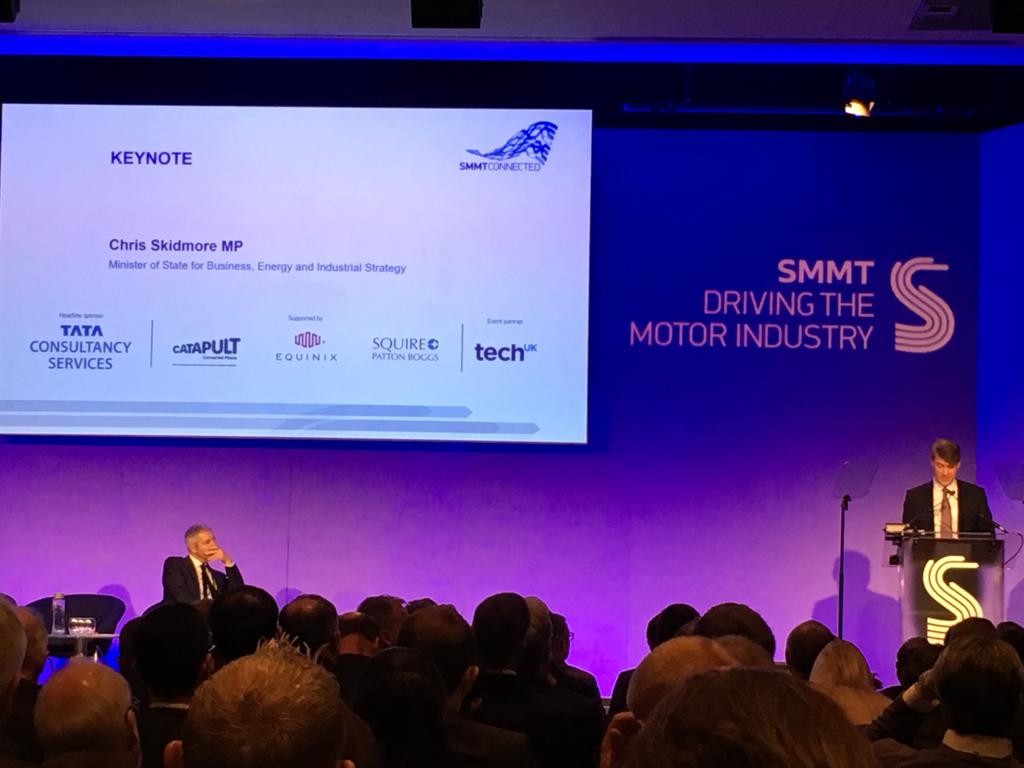The Society of Motor Manufacturers and Traders, the UK’s trade association for car makers, hosted their third annual SMMT Connected on 4 April to showcase new technological solutions for automotives, but also made space for attendees to discuss how they planned to deal with a changing sector as connected and autonomous vehicles (CAVs) come into wider use.
For example, SMMT Chief Executive Mike Hawes used his introductory speech to talk up what benefits he thought CAVs could bring in three main areas:
- Increase in safety and a reduction of accidents;
- Reduction of traffic jams and increased road management efficiency; and
- Reduction in emissions.
How can these be achieved? According to Hawes, aligned regulations, interoperability and data governance are key to achieving a seamless introduction of CAVs and the UK, despite following the trends, needs to push forward and work internationally.
Augustin Martín, CEO of Toyota Connected Europe, and Andy Palmer, CEO of Aston Martin Lagonda, were on hand to echo Hawes’ priorities and describe their companies’ approaches to the evolving CAV market. Simply selling more private cars, now with connectivity or self-driving capability, will of course do nothing to achieve Hawes’ three benefits — and, according to Palmer, Aston Martin will remain focused on rethinking luxury experiences and not chasing the mass market. However, Toyota Connected, Toyota’s mobility-focused spin off, is a more interesting proposition.
According to Martín, Toyota is interested in re-positioning ‘from an automotive manufacturer to a mobility company.’ Mobility services like proving platforms for ride and car sharing, fleet management, and remote operations provided 6% of Toyota’s revenue in 2017, said Martín, but they expect that to grow to 30% by 2030. ‘Consumer expectations are changing’ Martín told the audience. ‘Attachment to the car is wearing out, and there are other ways of looking at transportation from a consumer perspective.’
A pivot from providing cars to providing mobility is welcome news for Chris Skidmore, Minister of State for Business, Energy and Industrial Strategy, who attended to provide the government’s point of view and highlight the need for government-industry cooperation and international partnerships. ‘We can’t meet this unprecedented global co-operation with unprecedented isolation’ he said. ‘We’re looking at the change from driving as a skill to mobility as a right, opening transport to the disabled, elderly or those simply too young to drive.’
Planning for the connected future
Several panels bringing together experts from the public and private sector were held to discuss and evaluate the potential benefits and hurdles to the implementation of CAVs.
The first panel on smart mobility discussed the future of mobility solutions and focused mainly on urban areas. ‘The solutions we’re looking at have to work for the 15% of people who don’t use apps or those who can’t get around as easily’ said Michael Hurwitz, Director of Transport Innovation at Transport for London and chair of the panel. Panellists put forward cooperation between actors and the development of multi-model spaces, with the seamless integration of the different mobility solutions, as ways they can achieve these solutions. The lack of adequate regulation remains one of the key impediments to this rapidly evolving environment.
Discussions went on to focus on the use of data as a key enabler to the deployment of CAVs. From creating an integrated digital ecosystem to the personalisation of services, innovative use of data is integral to connected mobility — although panellists highlighted growing concerns on privacy and cybersecurity. The importance of secure infrastructure and protocols were discussed thoroughly. Panellists agreed on the importance of data sharing to create an integrated digital ecosystem but also acknowledged the difficulty of putting it into practice.
The importance of a harmonised set of regulations was highlighted several times during the panel discussions. Several speakers also pointed out the impact of international cultural and social differences often dictates the openness of a specific market to change and innovation.
While SMMT made clear that there is a lot of inertia from international corporations, more interesting propositions exist and can be boosted if they resolve technical and regulatory concerns. Removing these blockers will allow a seamless integration of connected and autonomous vehicles into transport infrastructure, and potentially allow more interesting ideas to develop that change roads to be safer, faster and cleaner.
Author: Kevin Eisenhauer, Spectrum Engineer, Access Partnership

